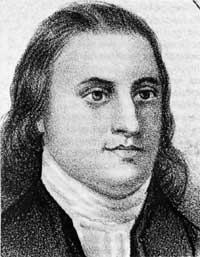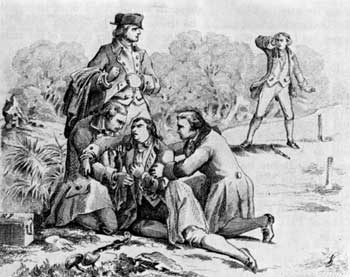







Biographical Sketches
|
BUTTON GWINNETT Georgia |
 Button Gwinnett | |
| ||
Gwinnett was likely born in 1735, at the village of Down Hatherly, Gloucestershire, England. The second male in a family numbering at least seven, he was the son of an Anglican vicar of Welsh ancestry and a mother with English ties. He probably learned trade and finance from an uncle, a Bristol merchant, and in 1757 moved to Wolverhampton, Staffordshire. He married a grocer's daughter, who was to bear three girls, and for a time he joined her father in a partnership. In 1759, however, Gwinnett entered the export shipping business and built up an extensive trade with the American Colonies, possibly sometimes visiting them himself.
The date of Gwinnett's emigration to Savannah, Ga., is not known but in 1765 he purchased a store there. Later that same year, for some reason, he sold it and abruptly switched vocation. Apparently dazzled by visions of a planter's life on a great estate but undeterred by his lack of capital, experience, and training, he borrowed £3,000 and purchased large St. Catherine's Island. It was located off the Georgia coast not far from the busy mainland port of Sunbury, a rival of Savannah. At this time, he probably erected a home on the island. Before long, though already deep in debt, he also purchased some coastal lands on credit and received grants of others from the colony; and bought large numbers of slaves to work his holdings. Poachers aggravated his problems by raiding the island's livestock.
Gwinnett's land, slaves, and other possessions were soon gobbled up by creditors. Finally, in 1773, they took over the island, but allowed Gwinnett to maintain his home there. He did so for the rest of his life. During the war, however, the approach of British vessels, who replenished their food supplies from the livestock on the exposed island, sometimes forced him and his family to scurry over in their boat to Sunbury for temporary refuge.
 |
| Fanciful depiction of Button Gwinnett's duel with Gen. Lachlan Mcintosh in 1777 that resulted in the former's death. (Lithograph, probably by an artist named Ferris, from William Brotherhead, The Book of the Signers, 1861, Library of Congress.) |
Meantime, Gwinnett had long since entered politics. In 1768-69 he had been designated as one of His Majesty's justices of the peace and as a local pilotage commissioner. In the years 1769-71 the voters of St. John's Parish elected him to the colonial assembly at Savannah, but he attended only spasmodically because of his financial woes. When they worsened, he left public office for 5 years.
Gwinnett returned on the national level. Unlike the other two Georgia signers, Lyman Hall and George Walton, he belatedly joined the patriot side—apparently held back for some time by his English birth and close family connections in England. His friend Hall, a Sunbury resident and fellow member of the Midway Congregational Church, swung him over, probably beginning in the summer of 1775. The next February, the provincial congress named Gwinnett to the Continental Congress, though he did not arrive in Philadelphia until May. He attended for only about 10 weeks. Right after he signed the Declaration on August 2, he trekked back to Georgia, where he hoped but failed to win at least an Army colonelcy in one of the units the State was forming.
In October Gwinnett was reelected to the Continental Congress, but chose not to attend. Instead, during the next 5 months, he played a key role in drafting the State's first constitution, in the course of which he helped thwart a proposed union of South Carolina and Georgia. Upon the death of the Governor, or president of the Executive Council, in March 1777 the council commissioned Gwinnett as Acting Governor for 2 months, but he failed to achieve reelection. Before leaving office, he had clashed with controversial Gen. Lachlan McIntosh, an old rival. The result was a pistol duel in May just outside Savannah. Both men suffered wounds, but Gwinnett died a few days later of a gangrenous infection in his leg. Colonial Park Cemetery in Savannah contains a grave reputed to be his.
Drawing: Detail from the lithograph "Signers of the Declaration of Indpendence," published by 1876 by Ole Erekson, Library of Congress. The detail is a conjectural representation; no portrait or reliable likeness of Button Gwinnett is known to exist.
 |
 |
http://www.cr.nps.gov/history/online_books/declaration/bio13.htm
Last Updated: 04-Jul-2004